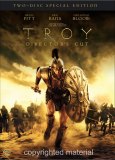| Reviews & Columns |
|
Reviews DVD TV on DVD Blu-ray 4K UHD International DVDs In Theaters Reviews by Studio Video Games Features Collector Series DVDs Easter Egg Database Interviews DVD Talk Radio Feature Articles Columns Anime Talk DVD Savant Horror DVDs The M.O.D. Squad Art House HD Talk Silent DVD
|
DVD Talk Forum |
|
|
| Resources |
|
DVD Price Search Customer Service #'s RCE Info Links |
|
Columns
|
|
|
Troy - Director's Cut
Warner Bros. // R // September 18, 2007
List Price: $20.98 [Buy now and save at Amazon]
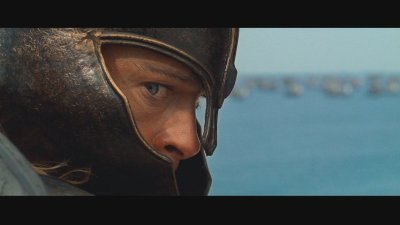
Most literate individuals hold some grasp on Homer's "Odyssey", as it was probably jammed down their throat in literature courses. This weighted pressure of a genius' work on students is both a travesty and a blessing since Homer's lyrical presence is so unparalleled, yet not a narrative style to be forced. But what about Homer's arguably superior work, "The Iliad", and the epic tale of Troy continued through Vergil's "The Aeneid"? To bring an expensive version of this magnificent narrative to the big screen begs for greatness. At the same time, is it really possible, or necessary, to cram all of its literary nuances into film form?
That's the daunting task that Wolfgang Petersen, director of Das Boot and The Neverending Story, attempted to take on with his 2004 summertime confection, Troy. The costumes, acting, action, and other tangibles were all in line for big-budget consumption. But, there was something missing. In fact, there was a plethora of elements missing that made the "flick" nowhere near as adherent as the ancient tale in comparison. Most importantly, a lot of the decisions made when filtering the film in the final product stage really sucked the essence of Homer's poem out. The film did well at the box office as a May to August thrill ride, but lacked in lasting appeal.
Now, Petersen has given his epic film another crack in a director's cut of Troy. With "30 Minutes of Never Before Seen Footage", Troy is longer, bloodier, and much more sprawling in scope. More importantly, it recovers the stolen spirit lost in the theatrical cut. In short, Troy: The Director's Cut, though still not the perfect marriage between Homer and the cinema screen, stands strong as a more enthralling and sweeping epic that easily trumps its predecessor.
The Film:
Note: Not exact frames.
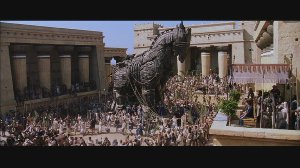
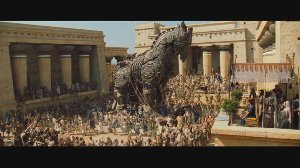
Greed. Power. Love. Fame. Honor.
The story of Troy is one of multiple layers and motivations, but most of the conflict lies within the Greek conqueror Agamemnon (Brian Cox) and his gallant champion Achilles (Brad Pitt). Agamemnon leads his army across the world for global domination, needing nothing more than a hint of desire to march upon a country. His bickering relationship with the egotistical Achilles still pans out as success within the battles, purely because of Achilles' bloodlust for fame flowing through his half-deity body. The want, the desire, and the greed soaked with conquest are what brings a brutal war upon themselves.
Amorous motives within the eyes and arms of Paris of Troy (Orlando Bloom) and Helen of Sparta (Diane Kruger), however, are our catalysts. While on a peace mission for Troy, both Trojan princes Hector (Eric Bana) and Paris work as liaisons to their King Priam (Peter O' Toole) to assemble a relationship with the Spartan king Menelaus (Brendan Gleeson), husband to Helen. What they didn't plan on was the growing love that blossomed between Paris and Helen into a sordid affair. After their efforts lead to success and the Trojans sail home, Paris reveals his cataclysmic decision to bring the beautiful Helen to Troy. Once Menelaus discovers her departure, he retreads to his brother, none other than Agamemnon, to storm Troy in an effort to bring her back. Agamemnon, not caring one way or another about Helen, accepts this opportunity to violently take Troy and add the city to his collection. Without Achilles and his band of loyal warriors, however, Agamemnon will not succeed.
Ultimately, our focus trails towards both the mounting war and Achilles. After a little coercion from Odysseus (Sean Bean), he starts to contemplate whether or not to fight for Agamemnon any longer. When he goes to his mother, the water goddess Thetis (Julie Christie), for counsel, she instead bequeaths something akin to a prophecy upon him. If Achilles decides not to venture forth into Troy, he'll live a pleasant life without everlasting fame. However, if he goes to Troy and engages in the battle, he will achieve such vast greatness that his name will be remembered forever. The choice lying before Achilles encompasses the eternal division between immortal fame and a quiet, pleasant existence.
As epic narratives go, "The Iliad" holds everything you could possibly want within a phenomenal story. Heroic battles, great character relations, and terse motives pump with full enthralling adrenaline within the pages of Homer's poem. Furthermore, its brutality begs for gore-hungry buffs to consume every ounce of crackling bones and dramatic impaling. When you look at the components, "The Iliad" sounds like it could translate phenomenally to film. But is it possible to make such sprawling narrative rich with undertones and context come to life flawlessly? Wolfgang Petersen attempted this with Troy, as well as cramming in some of Vergil's "The Aeneid" for good measure in telling the complete story. With an enormous budget and incredible talent, he pieced together a lush film packed with bombast and adrenaline. It was attractive and marginally entertaining, but fairly unsatisfying. What it lacked was the source material's raw essence.
Theatrical Cut vs. Director's Cut:


At times, systematic rundowns of additions and subtractions for certain films' alternate cuts wiggle into reviews. This has grown exceedingly difficult with recent large scale epic re-imaginations and, in my humblest opinion, detract from these fresh experiences. These lists can be useful for smaller reformulations, but not for completely different "events". As is the case for Petersen's new cut of Troy. In short, this Troy waves a much more epic, sexy, brutal, and beautiful flag that heartily grabs your attention. Above all else, it flexes strength far beyond its theatrical counterpart. You won't need a list of scene-by-scene alterations to guide you through this.
Petersen has jumped back into Troy with his hair down, packing a desire for an expansive and beautiful picture without the constraints for a marketable film. After a second screening of the theatrical film taken directly before viewing this cut, I felt the same hollowness that I felt with my first time through. As a casual lover of Homer's literature, I couldn't shake the feeling that the film didn't do the narrative the slightest bit of justice. It was a loud sword-and-sandals picture that skimmed the cream from the top of an incredible story. Costumes, casting, cinematography ... Troy, as a whole, was very pretty with an outstanding, underused cornucopia of actors. Alas, Troy disappointed me, basically because I saw what loomed underneath its depths. It felt like a gorgeous, capable bird with clipped wings.
For starters, don't be fooled by the "Unrated: 30 Minutes" moniker plastered on the cover of this new edition. There is much more unseen and unheard in Troy than you'd expect. Sure, the film spans over 190+ minutes, nearly 40 minutes longer than the public cut. You'll recognize the difference with the very first shot of a trotting dog scurrying across the outskirts of the battlefield. We're working with new material, and I'll address that in a moment.
Sound and Image:
First, Troy is going to look and sound a great deal different than you'll remember. As you can imagine, slapping an extra 30+ minutes into the film cries out for seamless alterations with the musical accompaniment. Thankfully, a new score has been formulated for this director's cut. One of my problems with the flow of the theatrical edition was the brusque yet gratingly bland music accompanying a lot of the scenes, especially with the key one-on-one battle in the film. We're working with a newly engineered score here that holds a quieter, more sweeping flare. There's a lot of intricate beauty within this new track, filled with identifiable nuances and gentle eccentricities. It's incredible how the demeanor of a film can shift purely due to a change in music. This cut boasts a strong complimentary effect with its proportionate score, especially when it stretches a once obnoxiously loud film into a leaner, more beautiful work. But the new beauty in the film aesthetics doesn't stop with the music.
Update - Here's a side note after some further aided discovery: A lot of Horner's original score remains within this track; however, it has be drastically re-edited and formulated to better accompany the demeanor of the film. A couple of tracks have been included that appear in different films, as has one of Gabriel Yared's original song elements in the form of vocal accompaniment with a funeral sequence (discovered to be "Mourning Women" after a little digging). It's interesting; while listening to the track, it holds such a full and sumptuous persona that it doesn't feel that close to the same accompaniment. Some of the particulars felt reminiscent of the original music, but it undoubtedly holds a vastly different attitude.
The prior note about the "Additional Music" has been removed.


When you take a look at the negative across the film, you'll notice that the overall presence of the film's core remains intact. You'll recognize a lot of the photography, but something will seem different. Troy has received a boost in color. Whether this injection of hues leans closer to the theatrical negative or enhanced for visualization purposes, I can't be certain. What is clear is that Troy looks absolutely astounding, especially within this fully saturated blue and tan palette. What was once an echoed, bland azure within water now starkly shines with turquoise splendor. Glistening gold statues in the sunlight aren't a dull tinge, but more like the awe-inspiring nuggets that we'd come to expect from ancient gold. This color shift gives Petersen's new film a large boost with something it was missing: a fantastical, whimsical demeanor that the epic story of Troy should have.
Something else will come across differently with the visuals. You'll notice that the editing seems marginally altered, with a few items rearranged. Some of those minor tweaks really aid in Troy's new poise. They give slight, tinkering changes to the demeanor of our characters. Here's an example: As Achilles and Briseis sit in his tent conversing at their first meeting, one of his soldiers walks in to have a word with him. In the theatrical cut, there was a sloppy cut straight onto the soldier's face. In this expanded edition, we don't leave Achilles and Briseis' sight, continually focusing on their demeanor while his head pops in and out. It's slight, but it gives an added dash of personality and focus we need in this film.
Petersen has also taken his focused lens and stepped back a few notches in several sequences to infuse more of the, well, Greco-Roman spirit to his film. Put bluntly, there's a speckle or two of nudity, both male and female (though nothing offensive), in this cut that are present yet unseen in the theatrical cut. Aside from adding the implicit sex appeal to these scenes, it also gives us more of the zest that an ancient era film should have. Across literature and antiquities, the male and female form is explicitly displayed around the Grecian and Roman eras. Troy harnesses just a shade more of that persona this time around.
New Material:
But let's nudge sound, color, and skin aside here for a moment, because that's not exactly what draws people towards a fuller cut of a film. How, in full context, is the new content in Petersen's director's cut of Troy compared to the theatrical cut? In a word, seamless. Though it doesn't change any relationships or alter any conclusions, the new material rapidly replenishes the film's vacant attitude in sweeping fashion. From the first shots of a dog running to find his master on the outskirts of a battlefield to the added helping of Odysseus' back-story, we're given some new enticing glimmers that slap a lot more meat on the bones. We see more of Paris and Helen's relationship, as well as Hector's intervention against Paris for such an activity. At times, it's easy to forget that Helen is, in essence, the cause of the Battle for Troy. The focus still leans too far on the physical war instead of the novel's even-keeled focus on battle, love, and a fame-hungry warrior's growth. However, with these added dashes, it harnesses the essence of the narrative and the time period with a much tighter and enjoyable grasp.


One of the arguments about Troy's problematic disagreement with "The Iliad" is that the book holds a much bloodier and brutal tone. Rest assured, this discrepancy has also been taken into account. Care for a dish of dismemberment, impalement, puncture, blood, guts, gore, and all-around fiery battle frenzy with the adapted story of Troy? Then this cut is for you, because you'll be pleasantly surprised at how brutal Petersen's new cut is in comparison. There's several added sequence featuring Ajax, a downplayed character in the film with a more prominent part in the book. His barbarity in the film only piqued a few times in the theatrical cut, whereas in this cut he's a fierce machine who gets nearly as much accomplished on the battlefield as Achilles. Where the battle in Troy felt like generic summer blockbuster fare almost worthy of a nap, these new additions to the battles are packed with tense grandiose that'll really suck you in.
Troy's theatrical cut lacked one other thing in particular that it desperately needed: narcissism. This is the one, and probably the only, time you'll hear these words pour onto one of my reviews. Narcissism is required for the hubris of these warriors, not just Agamemnon. And, with this new, expansive cut of Troy, hubris, especially within Achilles, oozes forth with more exuberance than the original cut. I had stringent problems comparing the strength and heartlessness of Achilles in the film to Achilles in the book. He seemed soft, tangibly soft, in the original cinematic version. With a little work in the editing room that includes a few small alterations and expansive stretches, Achilles feels more heartless, egotistical, and rugged. At the start, Pitt's casting as Achilles irked me something fierce. With Petersen's first go in the theatrical attempt, I was proved wrong in aesthetics and persona. His fervency has been tinkered and tooled with in the director's edition, and Achilles feels more like the engulfing menace and boastful anti-hero that we would come to expect from the pages of "The Iliad". However, the film still retreads heavily from emphasizing Achilles' fiery rage. He's not perfect, still boasting a bit more heart than I'd like to see from Achilles, but is a bit more adherent and gritty during his "humanization" in the book than before.
Impressions on the Director's Cut:
You might be thinking to yourself: Color saturation? Nudity? Guts? Is all this exploitative excess packed in with a few extra scenes under a Director's Cut label just to sucker me into a purchase? The answer is no, even though it might seem that way. This material isn't simply slapped into the cut for the sheer delight in selling discs for a little "unrated" action. Instead, these choices grandly transform Troy into more of the epic, battle-worn tale that a Greco-Roman story of Troy should be. The added gravitas pumps the film full of personality, one which the initial cut lacked.
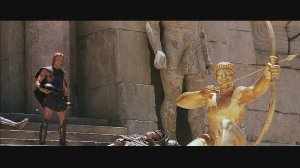
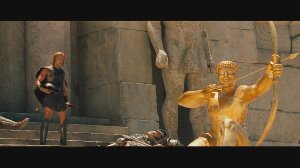
There's still a few aching problems with Troy, even with these grand changes. It's reasonable to assume that some thematic liberties need to be taken to make a story more "cinematic". However, there's a difference between shifting dynamics for on-screen adaption and making underplayed assumptions about the audience's ability to grasp relationships. One effort Petersen uses that could've been dodged is a weak attempt to connect characters by family ties. It seems that everyone has to be everyone else's cousin to share impact within the film. It's an effort to cut corners that works, sort of, but really detracts from the strength of these core relationships. While forgivable, there are a few other corners attempted to be cut that are a little more glaring, such as a lack of emphasis on the Battle of Troy's length. Many sacrifices in accuracy are made for entertainment value in Troy.
Instead of scratching your head over the inconsistencies in the theatrical cut, you're much more willing to accept these quirks in the new cut because it carefully locks us into an unwavering level of entertainment. Amidst these problematic differences, we're working with an end accomplishment that helps us to hold more belief in the story. The length and dialed-down thematic tone make the film quite acceptable as an epic film. It doesn't feel like a shallow distraction specifically thrown together to drink our hard-earned cash on a warm summer's day. Since the film is engineered to be a lot less choppy, it makes Troy much more usurping as a quality film. The same scenes feel quite different when accompanied by the altered score and displayed with some difference in connectivity and visual reformulation.
Overall, Petersen's film no longer feels like someone slashed out massive portions, pumped up the volume, and hit fast forward. Troy: The Director's Cut repairs these broken mistakes and injects the film with some much needed fuel. In comparison to the theatrical cut which, in its blitzed pace, felt every ounce as long as it 160+ minute run time, this new cut's alterations and adjustments make a three-hour film feel more like two. Plus, it's simply a more dramatically and brutally engrossing effort. Troy: The Director's Cut earns back the essence of Homer's narrative that we hoped to see at the start.
The DVD:
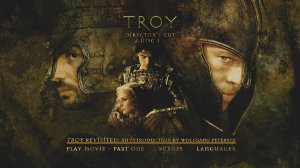
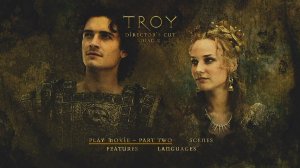
Bear in mind this review is covering Warner's standard Two-Disc Special Edition of Troy: The Director's Cut. While it in itself is a nice package with a slick, shiny slipcover around a standard keepcase, there is also an Ultimate Edition (MSRP $39.99) that comes equipped with art cards, a photo book, and exquisite collectible packaging in a digipack presentation. Assumedly, the transfer and extra material will be the same across each presentation.
The Video:
Apparently, somebody at Warner received the message that their recent standard definition releases were sloping downwards in video quality towards fumbling mediocrity. With Warner's quality transfers of 300 and this new cut of Troy, it looks like their ducks are back in that row they've become famous for. Troy: The Director's Cut's 2.35:1 anamorphic presentation is a work of radiance. It has plenty of breathing room since the film spread across both discs, but boy does it make use of that space.
What instantly stands out is the colors and shading within this pressing. Especially with skin tone, gold, and water, each and every palatable nuance screams in rich detail. At times, it almost feels like the elements are a bit "too" saturated; however, there's a wholly pleasing air hovering above this fluid presence of color. When you compare the two presentations, it looks almost like there was a very light blue, washed out veil draped over the original negative as it was transferred. This new DVD, however, harnesses color replication furiously. Skin tones grasp the olive hues that sun-baked warriors should have, while the glistening water ebbs and flows with a turquoise shade that looks much more inviting.
Instead of feeling very flat and digitally shackled, Troy: The Director's Cut shimmers in comparison with rich fluidity. Dense detail and texture pop with clarity, like unearthed sand as the boats hit the shore and the engraved details in Achilles' shield. Darker scenes echo with higher black levels, appearing much more solid and dark. There's still a little bit of digitization and mosquito noise present in the skies and against a few backdrops, but they are much more agreeable here. Troy: The Director's Cut is a wholly satisfying and rich visual experience.
The Audio:
Troy: The Director's Cut's aural presentation squeezes in with a strong Dolby Digital 5.1 presentation. Overall, it's a wholly suitable and engaging sound design that packs a reasonable punch within its intricate assembly. With the sound effects, each and every spear, shield, and sword clanked with fervency. Surround channels were used quite well with floating arrows and blazing flames, providing an eloquent stage for our enjoyment. The lower frequency channel operates more on grace than aggressiveness in this presentation, as it doesn't billow to a high degree. However, instead of "impressing" with fanfare blasts and raging thumps, the effects within Troy deftly support the material without absorbing the spotlight.
Most prominent in this design, however, is the music and vocal strength. Troy's brand new score sounds absolutely phenomenal. Every nuance and echoing note light up the speakers. We're given more of an opportunity to soak in the music with a quieter accompaniment, and this edition makes certain that we're able to hear the difference. With this presentation, each and every voice stands out with vibrant clarity. Very few words went out inaudibly, if any. Minor crisp details and overall absolute strength is where the sound excels. Dolby Digital 5.1 audio presentations are available in English, French, and Spanish, and subtitles are available for the same languages with the addition of English SDH captions.
The Extras:
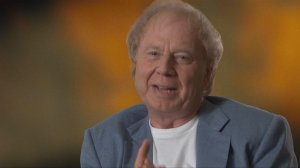
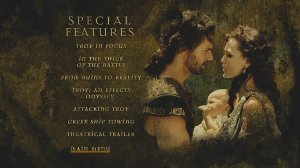
Fans of the film can relish in the fact that this new DVD carries over almost everything from the previous edition, as well as supplying a new quality section.
New to Director's Cut:
- Introduction by Wolfgang Petersen -
On Disc 1, we're treated to a minute and a half introduction from Wolfgang Petersen expressing his joy about this new cut of the film. It's a little bit of a dangerous watch since some of the new material flashes into view. Tt's not terribly spoiler-ish, but still something I'd probably prefer to watch after an initial viewing.
On Disc 2 ...
- Troy In Focus -
This is a collection of specific commentaries recorded for the Director's Cut that discusses many of the changes and decisions formulated for this specific cut, as well as some of the curiosities left after seeing the theatrical cut. Inn total, were' working with about 23 minutes of additional commentary separated generously into specific elements: Adapting Homer, On Set with Brad Pitt, Casting Helen, Agamemnon vs. Achilles, From Mexico to Malta, Troy: Battle and Weapons, Hector and Ajax, Briseas and Achilles: A Love Story, Two Great Warriors: Hector and Achilles, A King's Request: Priam and Achilles, and Troy: The Trojan Horse.
If some of ths material seems like it might be redundant, the added interview commentary earns its merit by giving us legit, worthwhile material rich with trimmings. If it seems covered from the first edition, such as the weapons discussion, then you'll be treated to some discussion on the added material in the Director's Cut.
Ported From Theatrical DVD Edition:
- In The Thick of Battle -
Covering the fight elements of the film, In the Thick of Battle spans around 17 minutes of coverage on the weapons, training of soldiers, as well as location and costume pains. There's a great deal of behind-the-scenes material that keep a documentarian feel. Commentary through interviews is included from Petersen and his crew of choreographers and production help. Chapters included are: The Weapons of Troy, Creating an Army, Beach Battle, The Achilles Heel, and Achilles vs. Hector.
- From Ruins to Reality -
This portion covers the assembly of Troy's overall look and feel through the eyes of history-weary cinematographers and set designers. From the build and the locational hazards of constructing ships on the beach to the erection of the great Trojan horse, we're treated to a great deal of insightful material. As with the rest of these featurettes, there's a lot of behind-the-scenes interviews and raw footage, including some frustrated material regarding stalls involving a hurricane and the production crew's efforts to save sea turtles. Chapters included are: The Real Troy, From History to Film, Battle on the Baja, Making a Decoy, Hurricane Marty, and Burning a Kingdom.
- Troy: An Effects Odyssey -
As can be expected, we're treated to an 8-minute span illustrating how computer-generated graphics assembled the sights and how sound designers threw together sounds unable to be captured naturally in Troy. As such, the material is separated into two parts to cover each element. It's pretty darn in-depth, especially once you dive into the sound room and the editor reaches into his bag of toys and demonstrates how separate effects are created. Chapters included are: Creating an Armada, View From Above, Filling the Gaps: CG Soldiers, Sounds of Fire, Sounds of Battle, Sounds of Force, and Sounds of Destruction.
- Attacking Troy -
Taking an alternate direction on adapting the source material, Attacking Troy focuses on achieving some of the battle ideas about the time period and the story while staying adherent to history. There's a lot of discussion about style and technique while working with nothing but a few etchings and tools from ancient times. Chapters included are: Homer: A Tale for the Ages, Designing a Fighting Style, and Flipping The Chariot.
- Greek Ship Towing -
Greek Ship Towing is a painfully unfunny animated cartoon featuring some of the raw computer elements used to piece together Troy. Aside from the final shot in this little "gem", there's not a lot of entertainment value in it.
- Theatrical Trailer -
Finally, a very fitting anamorphic Theatrical Trailer is included. Interestingly, this new cut fits much better with the trailer. It's a safe watch before the film begins, and a great way to fire up the mood.
Even though it seems like a majority of the bonus material is carried over, these special featues are expansive and high-quality enough to not be tinkered with. Add in the newer features that expand even further and we're working with a fairly comprehensive package. I'd like to see some of the direct book-to-script comparisons and a director's commentary, but everything we've got here is quite nice.
-----
Final Thoughts:
Troy: The Director's Cut comes very Highly Recommended, to anyone from any market. Here's a few different ways to look at it:
For those that haven't seen the film, this director's edition is undoubtedly the way to go. It's a fuller, richer, and more epic narrative packed solid with everything you'd be prepared to see from an action / adventure rendition of Troy's tale. Those that liked the original enough to own the flick or who saw it and didn't enjoy it, this cut is undoubtedly worth a look. You're working with a fantastic video and audio presentation, as well as the lion's share of extras from the original disc (The Gallery of the Gods portion doesn't seem to be on this new set). And, for those collectors who are looking into the HD-DVD or Blu-Ray version in comparison to the Ultimate Edition with all the beautiful supplements, you won't be terribly disappointed with the aesthetic presentation of the film itself - though a slight boost in sharpness in video and, especially, in audio might be worth your consideration.
No matter which edition you pick up, whether it's the Ultimate Edition, high-definition, or the beautifully cost efficient standard edition, Troy: The Director's Cut is a worthy, beautifully reengineered epic that's worth your time. Highly Recommended.
|
| Popular Reviews |
| Sponsored Links |
|
|
| Sponsored Links |
|
|
| Release List | Reviews | Shop | Newsletter | Forum | DVD Giveaways | Blu-Ray | Advertise |
|
Copyright 2024 DVDTalk.com All Rights Reserved. Legal Info, Privacy Policy, Terms of Use,
Manage Preferences,
Your Privacy Choices | |||||||









